Potential Geographic Distribution and Suitable Area of Three Species of Diabrotica (Coleoptera: Chrysomelidae) Beetles in Corn-Planting Regions of China
Simple Summary
Abstract
1. Introduction
2. Materials and Methods
2.1. Data Resources
2.1.1. Occurrence Data of Three Species of Diabrotica Beetles
2.1.2. Climatic Data for Model Development
2.1.3. Data on China’s Corn-Planting Areas
2.2. MaxEnt Model and Model Optimizing
2.3. Model Evaluation and Habitat Suitability Classification
2.4. Extraction of Potential Suitability Distribution in Corn-Planting Range
3. Results
3.1. Model Performance
3.2. Response and Contributions of Three Diabrotica Species to Environmental Variables
3.3. Current Potential Geographic Distribution of the Three Diabrotica Species in China
3.4. Overlay Analysis of the Current Potential Geographic Distribution of the Three Diabrotica Species and the Actual Distribution of Corn-Growing Regions in China
3.5. Changes in Potential Geographic Distribution Range of the Three Diabrotica Species in China in the Future
3.6. Analysis of the Response of Dominant Environmental Variables to the Potential Geographic Distribution Probabilities of the Diabrotica Beetles in the MaxEnt Model
4. Discussion
5. Conclusions
Supplementary Materials
Author Contributions
Funding
Data Availability Statement
Conflicts of Interest
References
- Branson, T.F.; Krysan, J.L. Feeding and Oviposition Behavior and Life Cycle Strategies of Diabrotica: An Evolutionary View with Implications for Pest Management. Environ. Entomol. 1981, 10, 826–831. [Google Scholar] [CrossRef]
- Meinke, L.J.; Souza, D.; Siegfried, B.D. The Use of Insecticides to Manage the Western Corn Rootworm, Diabrotica virgifera virgifera, LeConte: History, Field-Evolved Resistance, and Associated Mechanisms. Insects 2021, 12, 112. [Google Scholar] [CrossRef] [PubMed]
- Boiça Júnior, A.L.; Costa, E.N.; Nogueira, L.; Ribeiro, Z.A. Evaluation of Maize Genotypes on Oviposition Preference of Diabrotica speciosa (Germar). Arthropod-Plant Interact. 2022, 16, 691–698. [Google Scholar] [CrossRef]
- Spencer, J.L.; Hibbard, B.E.; Moeser, J.; Onstad, D.W. Behaviour and Ecology of the Western Corn Rootworm (Diabrotica virgifera virgifera LeConte). Agric. For. Entomol. 2009, 11, 9–27. [Google Scholar] [CrossRef]
- Moeser, J.; Vidal, S. Nutritional Resources Used by the Invasive Maize Pest Diabrotica virgifera virgifera in Its New South-East-European Distribution Range. Entomol. Exp. Appl. 2005, 114, 55–63. [Google Scholar] [CrossRef]
- Gray, M.E.; Sappington, T.W.; Miller, N.J.; Moeser, J.; Bohn, M.O. Adaptation and Invasiveness of Western Corn Rootworm: Intensifying Research on a Worsening Pest. Annu. Rev. Entomol. 2009, 54, 303–321. [Google Scholar] [CrossRef]
- Fishilevich, E.; Vélez, A.M.; Storer, N.P.; Li, H.; Bowling, A.J.; Rangasamy, M.; Worden, S.E.; Narva, K.E.; Siegfried, B.D. RNAi as a Management Tool for the Western Corn Rootworm, Diabrotica virgifera virgifera. Pest Manag. Sci. 2016, 72, 1652–1663. [Google Scholar] [CrossRef]
- Jin, Z.; Zhao, H.; Xian, X.; Li, M.; Qi, Y.; Guo, J.; Yang, N.; Lü, Z.; Liu, W. Early Warning and Management of Invasive Crop Pests under Global Warming: Estimating the Global Geographical Distribution Patterns and Ecological Niche Overlap of Three Diabrotica Beetles. Environ. Sci. Pollut. Res. 2024, 31, 13575–13590. [Google Scholar] [CrossRef]
- Venette, R.C.; Kriticos, D.J.; Magarey, R.D.; Koch, F.H.; Baker, R.H.A.; Worner, S.P.; Gómez Raboteaux, N.N.; McKenney, D.W.; Dobesberger, E.J.; Yemshanov, D.; et al. Pest Risk Maps for Invasive Alien Species: A Roadmap for Improvement. BioScience 2010, 60, 349–362. [Google Scholar] [CrossRef]
- Liu, C.; Wolter, C.; Xian, W.; Jeschke, J.M. Most Invasive Species Largely Conserve Their Climatic Niche. Proc. Natl. Acad. Sci. USA 2020, 117, 23643–23651. [Google Scholar] [CrossRef]
- Hastie, T.; Tibshirani, R.; Buja, A. Flexible Discriminant Analysis by Optimal Scoring. J. Am. Stat. Assoc. 1994, 89, 1255–1270. [Google Scholar] [CrossRef]
- Thuiller, W.; Lafourcade, B.; Engler, R.; Araújo, M.B. BIOMOD—A Platform for Ensemble Forecasting of Species Distributions. Ecography 2009, 32, 369–373. [Google Scholar] [CrossRef]
- Stohlgren, T.J.; Ma, P.; Kumar, S.; Rocca, M.; Morisette, J.T.; Jarnevich, C.S.; Benson, N. Ensemble Habitat Mapping of Invasive Plant Species. Risk Anal. 2010, 30, 224–235. [Google Scholar] [CrossRef] [PubMed]
- Guéguen, M.; Blancheteau, H.; Thuiller, W. biomod2: Ensemble Platform for Species Distribution Modeling, R package version 4.3-4. 2025. Available online: https://biomodhub.github.io/biomod2/ (accessed on 21 August 2024).
- Engler, R.; Guisan, A. MigClim: Predicting Plant Distribution and Dispersal in a Changing Climate. Divers. Distrib. 2009, 15, 590–601. [Google Scholar] [CrossRef]
- Ikeda, D.H.; Max, T.L.; Allan, G.J.; Lau, M.K.; Shuster, S.M.; Whitham, T.G. Genetically Informed Ecological Niche Models Improve Climate Change Predictions. Glob. Change Biol. 2017, 23, 164–176. [Google Scholar] [CrossRef] [PubMed]
- Tang, J.; Li, J.; Lu, H.; Lu, F.; Lu, B. Potential Distribution of an Invasive Pest, Euplatypus parallelus, in China as Predicted by Maxent. Pest Manag. Sci. 2019, 75, 1630–1637. [Google Scholar] [CrossRef]
- Tan, J.; Huang, A.; Shi, X.; Zhang, Y.; Zhang, Y.; Cao, L.; Wu, Y. Evaluating the Performance of BCC-CSM2-MR Model in Simulating the Land Surface Processes in China. Plateau Meteorol. 2022, 41, 1335–1347. [Google Scholar]
- Zheng, Y.; Yuan, C.; Matsushita, N.; Lian, C.; Geng, Q. Analysis of the Distribution Pattern of the Ectomycorrhizal Fungus Cenococcum geophilum under Climate Change Using the Optimized MaxEnt Model. Ecol. Evol. 2023, 13, e10565. [Google Scholar] [CrossRef]
- Kass, J.M.; Muscarella, R.; Galante, P.J.; Bohl, C.L.; Pinilla-Buitrago, G.E.; Boria, R.A.; Soley-Guardia, M.; Anderson, R.P. ENMeval 2.0: Redesigned for Customizable and Reproducible Modeling of Species’ Niches and Distributions. Methods Ecol. Evol. 2021, 12, 1602–1608. [Google Scholar] [CrossRef]
- Xian, X.; Zhao, H.; Guo, J.; Zhang, G.; Liu, H.; Liu, W.; Wan, F. Estimation of the Potential Geographical Distribution of a New Potato Pest (Schrankia costaestrigalis) in China under Climate Change. J. Integr. Agric. 2023, 22, 2441–2455. [Google Scholar] [CrossRef]
- Fielding, A.H.; Bell, J.F. A Review of Methods for the Assessment of Prediction Errors in Conservation Presence/Absence Models. Environ. Conserv. 1997, 24, 38–49. [Google Scholar] [CrossRef]
- Swets, J.A. Measuring the Accuracy of Diagnostic Systems. Science 1988, 240, 1285–1293. [Google Scholar] [CrossRef]
- Yoon, S.; Lee, W.-H. Assessing Potential European Areas of Pierce’s Disease Mediated by Insect Vectors by Using Spatial Ensemble Model. Front. Plant Sci. 2023, 14, 1209694. [Google Scholar] [CrossRef]
- Coats, S.A.; Tollefson, J.J.; Mutchmor, J.A. Study of Migratory Flight in the Western Corn Rootworm (Coleoptera: Chrysomelidae). Environ. Entomol. 1986, 15, 620–625. [Google Scholar] [CrossRef]
- Lampman, R.L.; Metcalf, R.L.; Andersen, J.F. Semiochemical Attractants of Diabrotica Undecimpunctata Howardi Barber, Southern Corn Rootworm, and Diabrotica Virgifera Virgifera Leconte, the Western Corn Rootworm (Coleoptera: Chrysomelidae). J. Chem. Ecol. 1987, 13, 959–975. [Google Scholar] [CrossRef] [PubMed]
- Lawrence, W.S.; Bach, C.E. Chrysomelid Beetle Movements in Relation to Host-Plant Size and Surrounding Non-Host Vegetation. Ecology 1989, 70, 1679–1690. [Google Scholar] [CrossRef]
- Meinke, L.J.; Sappington, T.W.; Onstad, D.W.; Guillemaud, T.; Miller, N.J.; Komáromi, J.; Levay, N.; Furlan, L.; Kiss, J.; Toth, F. Western Corn Rootworm (Diabrotica virgifera virgifera LeConte) Population Dynamics. Agric. For. Entomol. 2009, 11, 29–46. [Google Scholar] [CrossRef]
- Ciosi, M.; Miller, N.J.; Kim, K.S.; Giordano, R.; Estoup, A.; Guillemaud, T. Invasion of Europe by the Western Corn Rootworm, Diabrotica virgifera virgifera: Multiple Transatlantic Introductions with Various Reductions of Genetic Diversity. Mol. Ecol. 2008, 17, 3614–3627. [Google Scholar] [CrossRef] [PubMed]
- Hummel, H.E. Introduction of Diabrotica Virgifera Virgifera into the Old World and Its Consequences: A Recently Acquired Invasive Alien Pest Species on Zea Mays from North America. Commun. Agric. Appl. Biol. Sci. 2003, 68, 45–57. [Google Scholar]
- EFSA Panel on Plant Health (PLH); Bragard, C.; Dehnen-Schmutz, K.; Di Serio, F.; Gonthier, P.; Jacques, M.-A.; Jaques Miret, J.A.; Justesen, A.F.; Magnusson, C.S.; Milonas, P. Pest Categorisation of Diabrotica barberi. EFSA J. 2019, 17, e05857. [Google Scholar] [CrossRef]
- EFSA Panel on Plant Health (PLH); Bragard, C.; Dehnen-Schmutz, K.; Di Serio, F.; Gonthier, P.; Jacques, M.A.; Jaques Miret, J.A.; Justesen, A.F.; MacLeod, A.; Magnusson, C.S. Pest Categorisation of Diabrotica Undecimpunctata Howardi. EFSA J. 2020, 18, e06358. [Google Scholar]
- Zhang, L.J.; Yang, X.X. Warning the Invasion of the Hazard Pests—Diabrotica virgifera virgifera. Entomol. Knowl. 2002, 39, 81–88. [Google Scholar]
- Zhang, J.H.; Ma, F.; Cao, Y.X.; Huang, X.; Chen, H.; Chen, N. Potential Geographic Distribution of the Western Corn Rootworm, Diabrotica virgifera virgifera LeConte and Its Quarantine Measures in China. Plant Quar. 2009, 23, 9–12. [Google Scholar]
- Kirk, V.M.; Calkins, C.O.; Post, F.J. Oviposition Preferences of Western Corn Rootworms for Various Soil Surface Conditions. J. Econ. Entomol. 1968, 61, 1322–1324. [Google Scholar] [CrossRef]
- Branson, T.F.; Ortman, E.E. Host Range of Larvae of the Western Corn Rootworm123. J. Econ. Entomol. 1967, 60, 201–220. [Google Scholar] [CrossRef]
- Siegfried, B.D.; Mullin, C.A. Effects of Alternative Host Plants on Longevity, Oviposition, and Emergence of Western and Northern Corn Rootworms (Coleoptera: Chrysomelidae). Environ. Entomol. 1990, 19, 474–480. [Google Scholar] [CrossRef]
- Krysan, J.L.; Miller, T.A. (Eds.) Methods for the Study of Pest Diabrotica; Springer Series in Experimental Entomology; Springer: New York, NY, USA, 1986; ISBN 978-1-4612-9338-5. [Google Scholar]
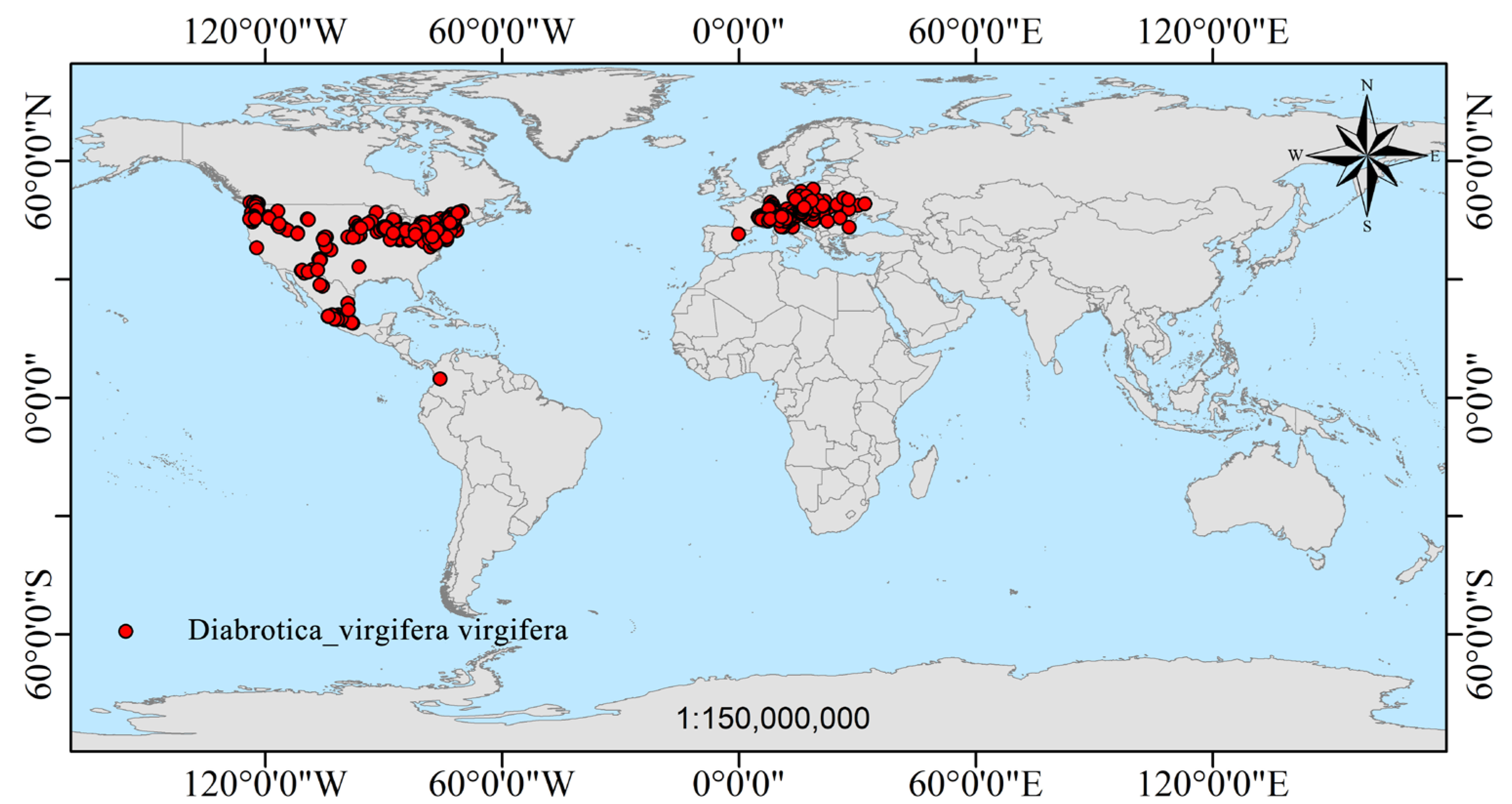
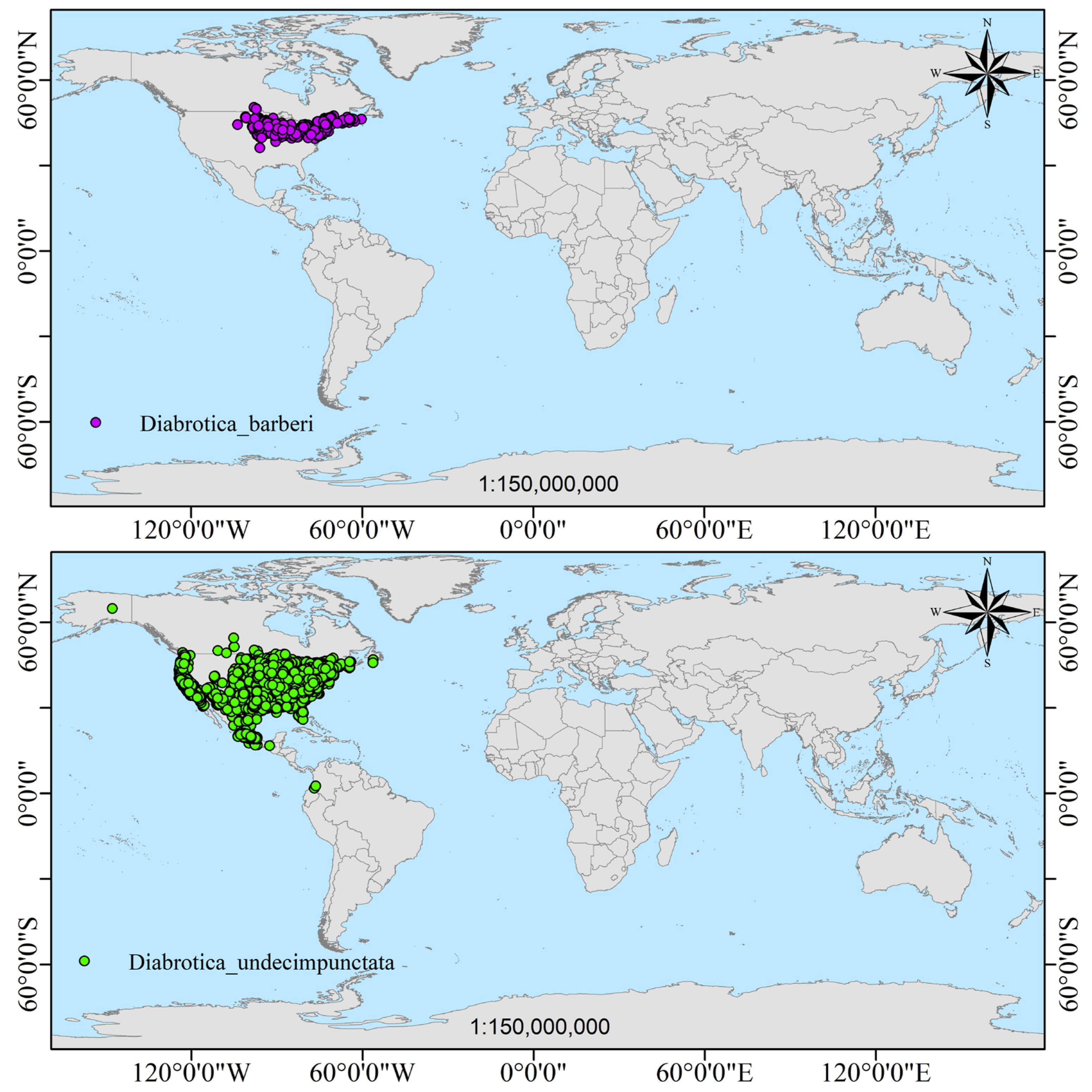
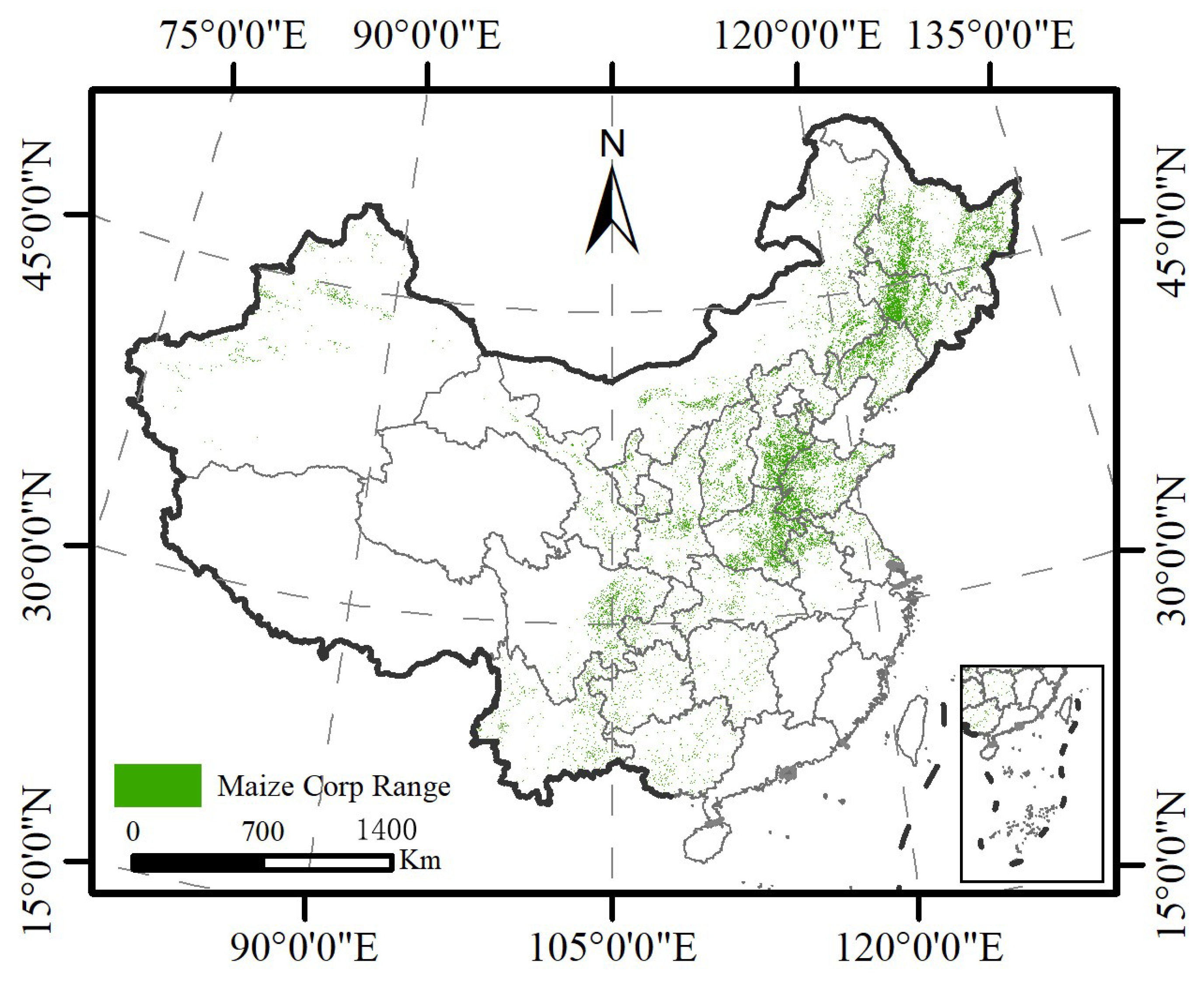
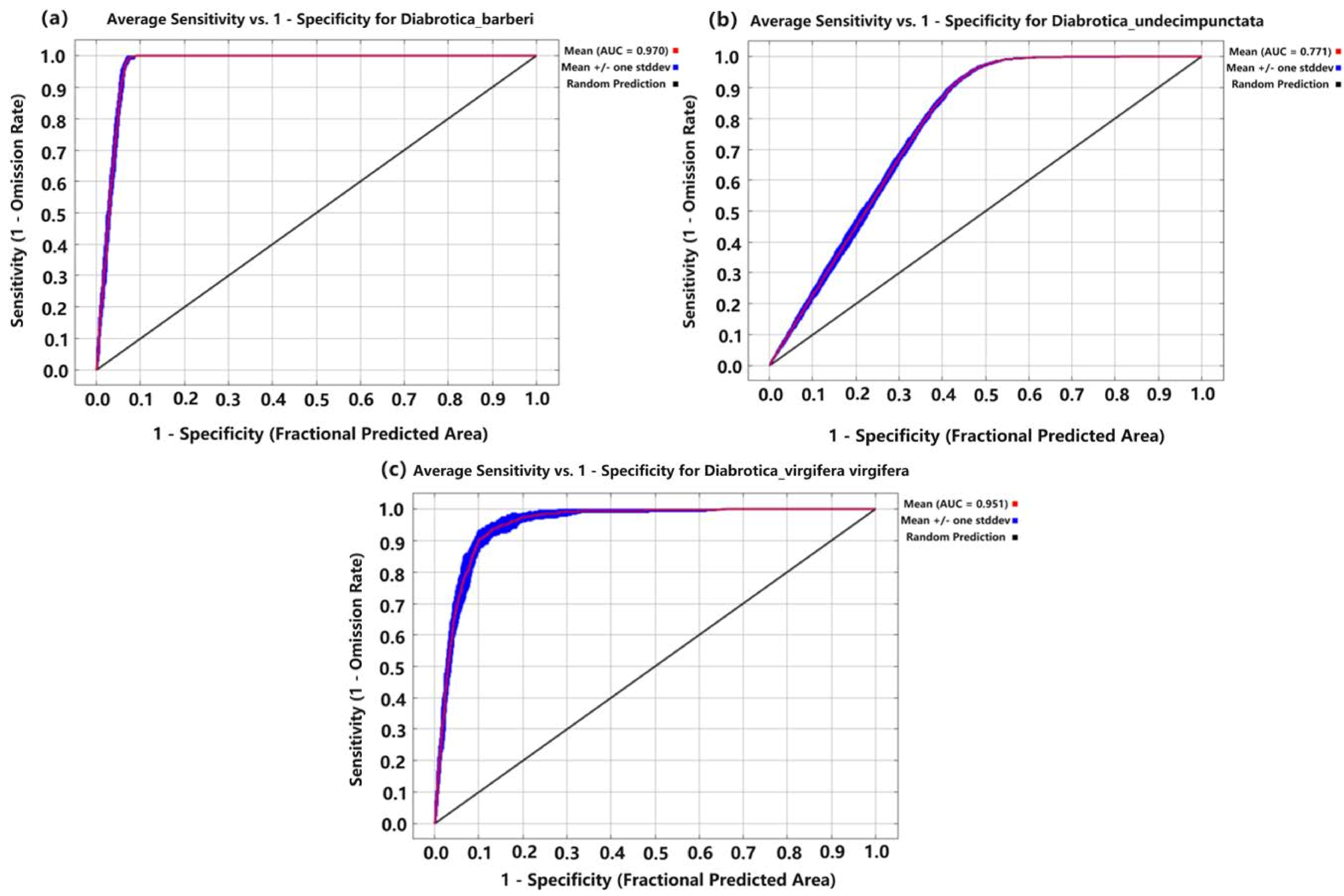

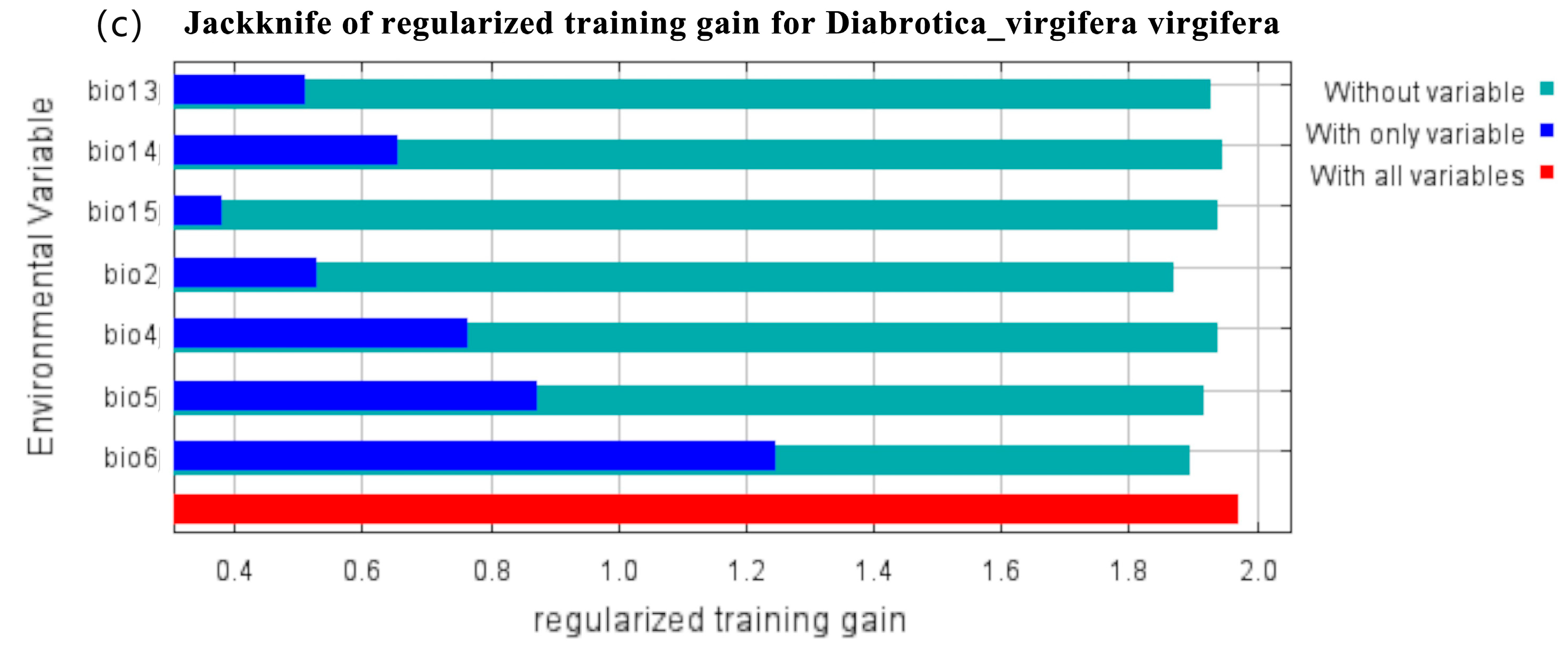

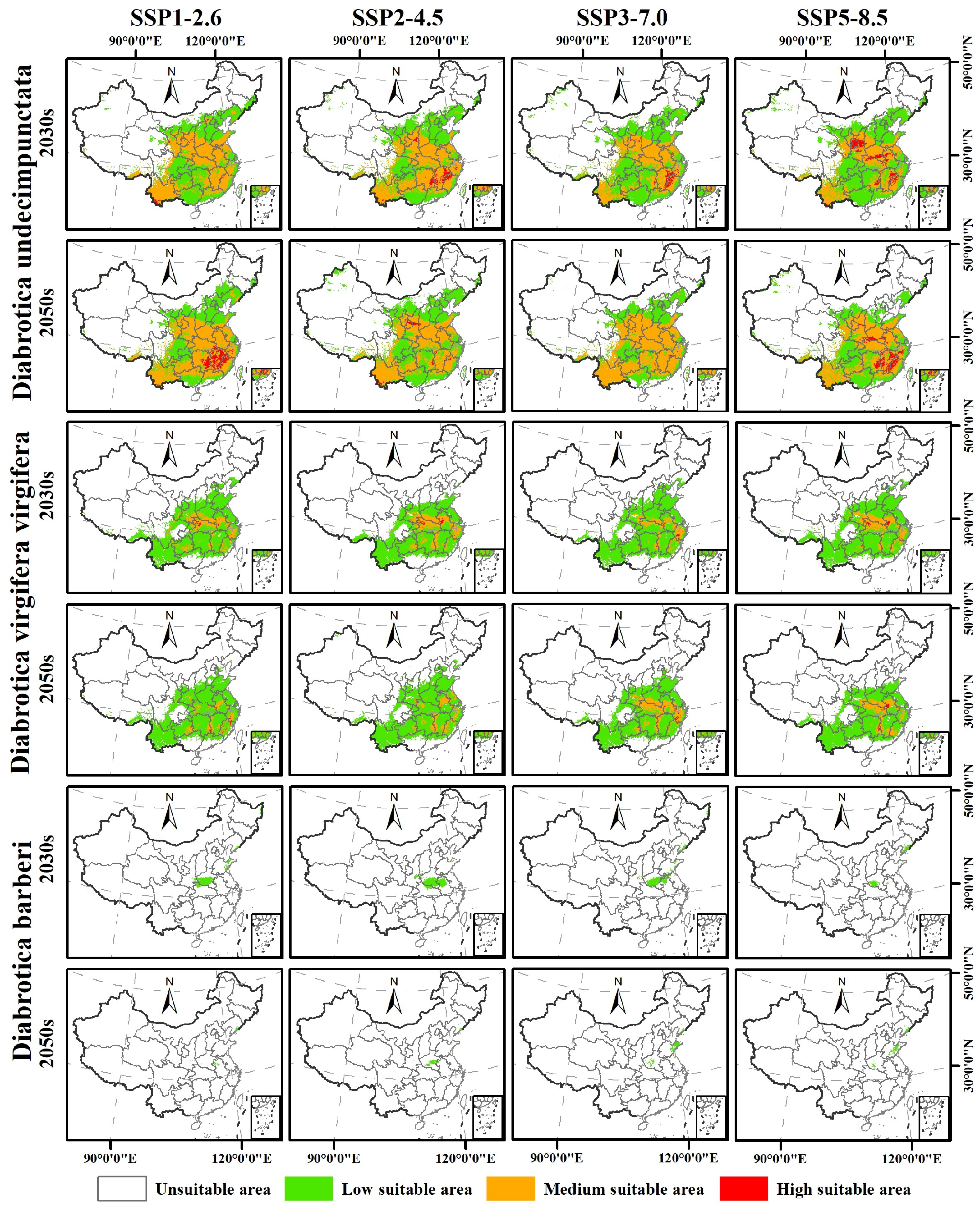

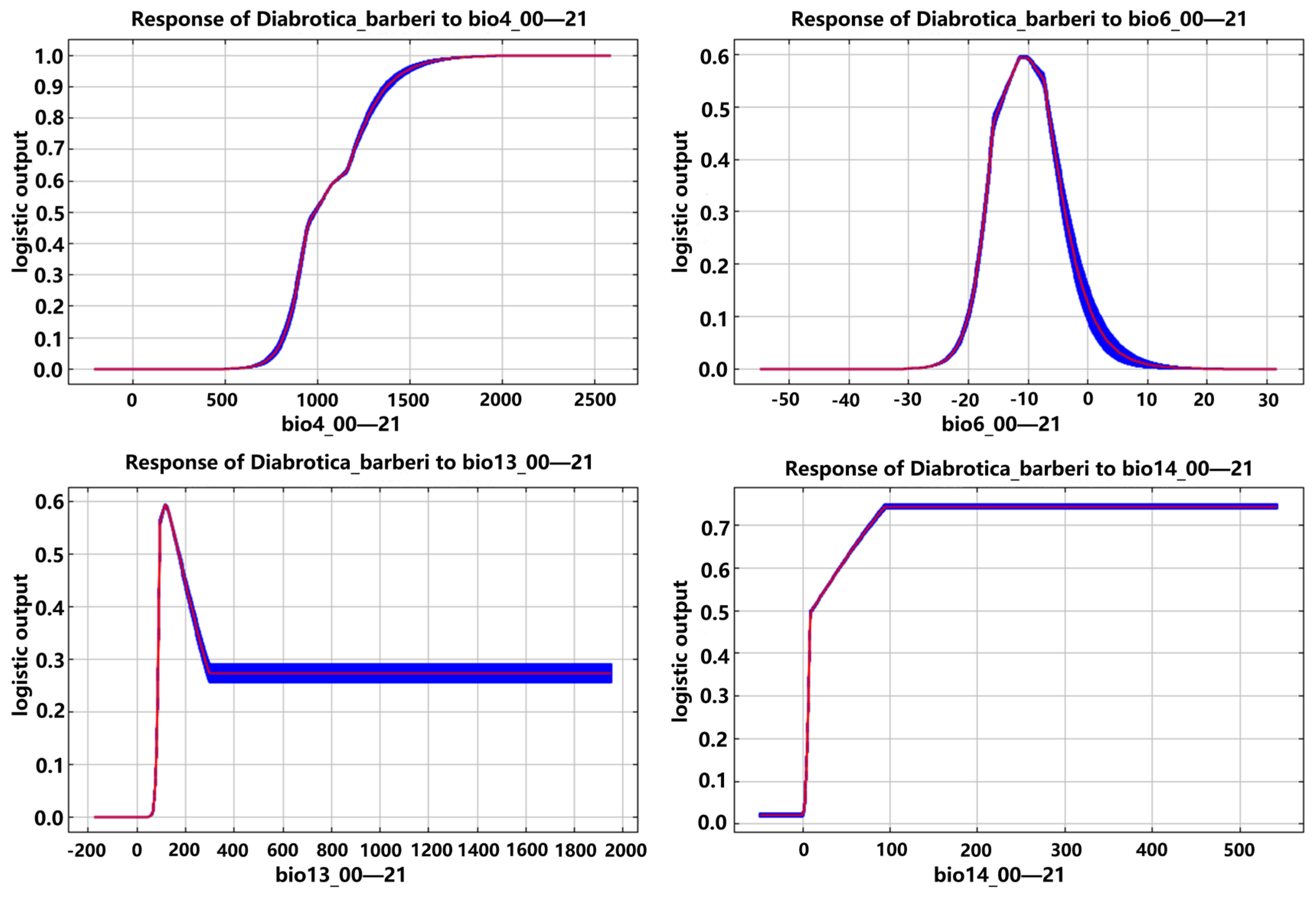


| Variables | Description |
|---|---|
| bio2 (°C) | Mean diurnal range (mean of monthly max temp—min temp) |
| bio4 | Temperature seasonality (standard deviation × 100) |
| bio5 (°C) | Max temperature of the warmest month |
| bio6 (°C) | Min temperature of coldest month |
| bio13 (mm) | Precipitation of wettest month |
| bio14 (mm) | Precipitation of driest month |
| bio15 (mm) | Precipitation seasonality (coefficient of variation) |
| Code | D. barberi | D. undecimpunctata | D. virgifera virgifera | |||
|---|---|---|---|---|---|---|
| Percentage Contribution (%) | Permutation Importance (%) | Percentage Contribution (%) | Permutation Importance (%) | Percentage Contribution (%) | Permutation Importance (%) | |
| bio2 | 0.6 | 1.4 | 3.3 | 6.2 | 10.2 | 7.7 |
| bio4 | 28.8 | 32.4 | 3.3 | 6.1 | 1.6 | 5.7 |
| bio5 | 6.0 | 7.7 | 10.5 | 11.6 | 12.1 | 3.4 |
| bio6 | 20.1 | 26.5 | 55.7 | 45.5 | 46.0 | 58.6 |
| bio13 | 27.9 | 27.8 | 19.0 | 20.5 | 5.9 | 12.3 |
| bio14 | 16.0 | 2.9 | 6.2 | 4.6 | 22.7 | 5.3 |
| bio15 | 0.6 | 1.3 | 2.0 | 5.5 | 1.5 | 7.0 |
| Highly Suitable Area (×104 ha) | Moderately Suitable Area (×104 ha) | Low Suitable Area (×104 ha) | Total Suitable Area (×104 ha) | |
|---|---|---|---|---|
| D. barberi | 0 | 0 | 287.7 | 287.7 |
| D. virgifera virgifera | 297.3 | 3409.7 | 21,354.2 | 25,061.1 |
| D. undecimpunctata | 1811.6 | 15,106.7 | 22,413.5 | 39,331.8 |
| Province | D. barberi | D. undecimpunctata | D. virgifera virgifera | ||||||
|---|---|---|---|---|---|---|---|---|---|
| H-Area (×104 ha) | M-Area (×104 ha) | L-Area (×104 ha) | H-Area (×104 ha) | M-Area (×104 ha) | L-Area (×104 ha) | H-Area (×104 ha) | M-Area (×104 ha) | L-Area (×104 ha) | |
| AH | / | / | / | 0.18 | 110.61 | 1.71 | 0.16 | 3.06 | 109.24 |
| CQ | / | / | / | / | 2.88 | 41.36 | 0.18 | 1.47 | 9.59 |
| GS | / | / | / | 0.04 | 45.46 | 43.74 | 0.36 | 3.41 | 38.36 |
| GX | / | / | / | / | 2.73 | 50.61 | / | / | 6.10 |
| GZ | / | / | / | / | 19.47 | 40.74 | / | 1.88 | 54.88 |
| HEB | / | / | 0.53 | / | 6.30 | 325.11 | / | / | 263.88 |
| HLJ | / | / | 21.75 | / | / | 1.54 | / | / | / |
| HEN | / | / | 0.06 | / | 359.61 | 20.44 | / | 38.89 | 341.15 |
| HUB | / | / | / | 2.81 | 52.39 | 22.05 | 2.01 | 41.05 | 34.19 |
| HUN | / | / | / | 3.04 | 18.31 | 14.58 | 0.02 | 3.37 | 31.91 |
| Inner | / | / | / | / | 1.93 | 85.22 | / | / | / |
| JL | / | / | 0.24 | / | 0.71 | 6.17 | / | / | 0.88 |
| JS | / | / | / | / | 28.83 | 22.59 | / | 0.03 | 49.22 |
| LN | / | / | 19.51 | / | 30.25 | 197.82 | / | / | 32.18 |
| NX | / | / | / | / | 8.05 | 23.02 | / | / | 4.24 |
| SAX | / | / | 1.18 | / | 110.15 | 9.50 | 2.54 | 28.55 | 60.71 |
| SC | / | / | / | / | 10.96 | 174.28 | 0.01 | 1.07 | 43.71 |
| SD | / | / | 0.03 | / | 92.02 | 301.24 | / | / | 382.48 |
| SX | / | / | 1.09 | / | 112.75 | 64.08 | / | / | 98.62 |
| TJ | / | / | / | / | / | 18.64 | / | / | 18.55 |
| XJ | / | / | / | / | / | 12.15 | / | / | 0.01 |
| YN | / | / | / | / | 80.30 | 41.63 | / | 1.57 | 104.59 |
| Total | / | / | 44.37 | 6.08 | 1093.71 | 1518.23 | 5.26 | 124.34 | 1684.49 |
| Species | Suitable Area | 2030s | 2050s | ||||||
|---|---|---|---|---|---|---|---|---|---|
| SSP1_2.6 | SSP2_4.5 | SSP3_7.0 | SSP5_8.5 | SSP1_2.6 | SSP2_4.5 | SSP3_7.0 | SSP5_8.5 | ||
| D. b | H-area | / | / | / | / | / | / | / | / |
| M-area | / | / | / | / | / | / | / | / | |
| L-area | 1367.7 | 1479.2 | 1512.0 | 623.3 | 191.9 | 374.1 | 539.3 | 446.1 | |
| D. u | H-area | 247.1 | 1011.1 | 700.8 | 1778.3 | 1732.1 | 486.3 | 122.0 | 1718.2 |
| M-area | 19,988.5 | 19,370.6 | 15,723.4 | 13,689.5 | 19,702.9 | 18,264.2 | 22,848.6 | 17,130.7 | |
| L-area | 19,760.9 | 19,475.0 | 22,502.1 | 23,554.9 | 17,251.8 | 21,356.6 | 14,574.6 | 17,364.8 | |
| Total-area | 39,996.5 | 39,856.7 | 38,926.3 | 39,022.7 | 38,686.8 | 40,107.2 | 37,545.2 | 36,213.7 | |
| D. v | H-area | 168.3 | 210.5 | 88.2 | 189.0 | 116.2 | 5.1 | 110.1 | 142.8 |
| M-area | 4577.5 | 4877.3 | 3276.1 | 4469.5 | 2587.5 | 2902.1 | 4880.7 | 3462.3 | |
| L-area | 23,083.2 | 19,897.7 | 22,497.0 | 22,166.2 | 22,883.4 | 22,923.8 | 19,810.3 | 19,898.4 | |
| Total-area | 27,829.0 | 24,985.5 | 25,861.3 | 26,824.7 | 25,587.1 | 25,831.0 | 24,801.1 | 23,503.5 | |
| Code | D. barberi | D. undecimpunctata | D. virgifera virgifera | |||
|---|---|---|---|---|---|---|
| Appropriate Range | Optimum | Appropriate Range | Optimum | Appropriate Range | Optimum | |
| bio2 | / | / | / | / | 7.8~21.7 °C | 18.2 °C |
| bio4 | 985.5~2589.1 | 1966.7 | / | / | / | / |
| bio5 | / | / | 24.7~37.6 °C | 35.6 °C | 24.4~32.7 °C | 27.8 °C |
| bio6 | −14.9~−6.8 °C | −11.1 °C | −10.3~7.8 °C | 4.4 °C | −12.4~3.7 °C | −2.6 °C |
| bio13 | 95.1~167.5 mm | 116.4 mm | 99.3~1951.3 mm | 286.7 mm | / | / |
| bio14 | 9.9~542.9 mm | 95.2 mm | 42.6~509.1 mm | 124.8 mm | 1.2~156.9 mm | 3.1 mm |
Disclaimer/Publisher’s Note: The statements, opinions and data contained in all publications are solely those of the individual author(s) and contributor(s) and not of MDPI and/or the editor(s). MDPI and/or the editor(s) disclaim responsibility for any injury to people or property resulting from any ideas, methods, instructions or products referred to in the content. |
© 2025 by the authors. Licensee MDPI, Basel, Switzerland. This article is an open access article distributed under the terms and conditions of the Creative Commons Attribution (CC BY) license (https://creativecommons.org/licenses/by/4.0/).
Share and Cite
Jin, Y.; Shao, F.; Zheng, S.; Wang, Y.; Hu, G.; Chen, F. Potential Geographic Distribution and Suitable Area of Three Species of Diabrotica (Coleoptera: Chrysomelidae) Beetles in Corn-Planting Regions of China. Insects 2025, 16, 1072. https://doi.org/10.3390/insects16101072
Jin Y, Shao F, Zheng S, Wang Y, Hu G, Chen F. Potential Geographic Distribution and Suitable Area of Three Species of Diabrotica (Coleoptera: Chrysomelidae) Beetles in Corn-Planting Regions of China. Insects. 2025; 16(10):1072. https://doi.org/10.3390/insects16101072
Chicago/Turabian StyleJin, Yening, Fan Shao, Sizhu Zheng, Yumeng Wang, Gao Hu, and Fajun Chen. 2025. "Potential Geographic Distribution and Suitable Area of Three Species of Diabrotica (Coleoptera: Chrysomelidae) Beetles in Corn-Planting Regions of China" Insects 16, no. 10: 1072. https://doi.org/10.3390/insects16101072
APA StyleJin, Y., Shao, F., Zheng, S., Wang, Y., Hu, G., & Chen, F. (2025). Potential Geographic Distribution and Suitable Area of Three Species of Diabrotica (Coleoptera: Chrysomelidae) Beetles in Corn-Planting Regions of China. Insects, 16(10), 1072. https://doi.org/10.3390/insects16101072








